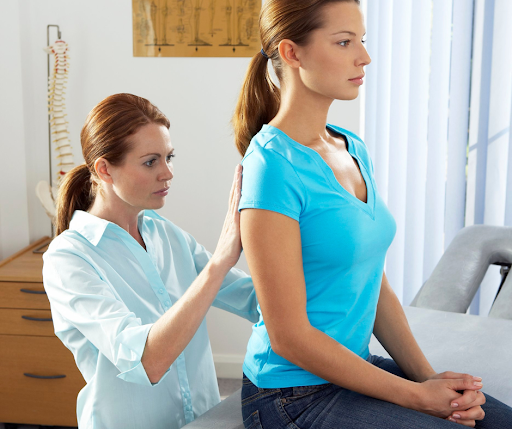Headaches—Are They Holding You Back? Learn Common Triggers
If you experience the sudden, acute onset of headache/pain accompanied by vision impairment, speech issues, body weakness, nausea or vomiting please seek medical attention immediately as this may be an indication of a medical emergency.
We all get headaches from time to time, but what does your headache pain tell you about your overall health? Let’s break down the different types of headaches and look at simple lifestyle habits to help minimize pain and reduce frequency.
Headache is defined as any pain or discomfort in the head or face. It may occur on one or both sides of the head, be isolated to a specific location, or radiate across the head. Headache can present as a dull ache, sharp pain, vice-like tightening, or throbbing sensation.
Headaches can originate from the muscles of the head, neck and shoulders, nerves in the face, throat, mouth, and scalp, and blood vessels found along the base and surface of the brain.
The International Headache Society has identified more than 150 different types of headaches. Headaches are classified into 2 main groups—primary and secondary.
Primary headaches are those that are not caused by another condition, but rather is the condition itself.
Secondary headaches are those that are related to an underlying medical condition such as trauma or injury, infection from sinusitis or of the jaw or teeth, cervical vascular disorder, hypertension, withdrawal from substances such as alcohol or caffeine, and medication overuse.
Migraine is classified as a primary headache. Migraine is more common in the female population, affecting 1 in 5 women, 1 in 16 men, and 1 in 11 children. Characterized by often debilitating pain accompanied by sensitivity to light or sound, nausea and vomiting, disruptions in the field of vision (aura) and can be crippling to those who are affected. The causes of migraines can be multiple from genetic predispositions to hormonal imbalances and from gut dysbiosis to barometric pressure changes.
Sinus headaches are usually accompanied by infection in the sinuses (sinusitis) and present as pain, pressure, or a feeling of fullness in the sinus cavities. The pain often intensifies when you bend forward or lay down. Sinus headaches and migraine have similar symptoms. Many people misdiagnose themselves as having sinus headaches, when in fact it is migraine. If you are experiencing frequent sinus headaches, it may be a good idea to talk to your doctor.
No matter what type of headache you may experience, the truth of the matter is you just want to find relief, and fast. While it is tempting to reach for ibuprofen or acetaminophen, these over-the-counter drugs are taxing on the liver and should be used sparingly. You may want to opt for a more natural remedy for immediate relief.
A drop or two of peppermint essential oil mixed with a carrier oil (olive, coconut, almond) and applied to the temples and back of the neck has been shown to offer relief for tension-type headaches. Do not apply undiluted essential oil directly to the skin.
A warm or cold compress can help alleviate pain. Most people prefer a cold compress for tension-type headaches and a warm for migraine. Experiment for yourself to see which you prefer.
Research has shown that tea or supplements made from the dried leaves of the feverfew plant reduce the severity and frequency of headache and migraine symptoms.
Often, light stretching and movement can help mitigate headache pain. Many headaches are caused by the tightening of muscles from the scalp and neck. Gently stretching the neck and massaging the scalp can help loosen strain and tension held in these areas.
While these are all quick solutions for an active headache, there are simple lifestyle habits you can incorporate in your daily life to recognize triggers, and even better, prevent headaches from happening in the first place.
If you are experiencing frequent headaches, I suggest keeping a journal to track symptoms, frequency, and severity. Make note of your meals and beverages, activities, sleep, mood, and any stressors. Keeping notes over the course of a couple of weeks can help find patterns in your life that may be at the root of headache symptoms, and can be a great tool to share with healthcare providers if needed. You may be surprised to find a link or trigger you may not have been previously aware of.
Headache and dehydration go hand in hand. Before you reach for an over-the-counter pain reliever, try drinking a large glass of water. It is estimated that 75% of North Americans are chronically dehydrated. Proper hydration is crucial for circulation, digestion and elimination, protects our cells, and is vital to keep you alive! Maintaining electrolyte balance in the body is important to keep in mind. Chugging litre after litre of water will not only have you running to the washroom, it can essentially flush electrolytes from the body. A pinch of high-quality sea salt in your water or electrolyte pouch will help maintain fluid balance within your cells.
Your pillow and sleeping position are an often overlooked factor to consider when finding relief for your headache woes. Sleeping on your stomach with a bunched-up pillow, or one that is too thick and fluffy will exaggerate the natural curvature of your neck. Conversely, a pillow that is too flat will not provide enough support. The ideal position for sleep is on your back or side with a firm, but comfortable pillow that supports the normal curvature of the spine.
Avoid Chemical Food Additives
MSG, aspartame, and tyramine are all common headache triggers. Avoiding processed convenience and fast foods is the easiest way to reduce MSG in your diet. It is a sneaky ingredient, disguised as many different names, you need to be a bit of a label-reading sleuth these days. Tyramine is a natural byproduct of the amino acid tyrosine. Tyramine can be found in naturally aged cheeses, red wine, smoked fish, cured meat, and some types of beer.
Paradoxically, caffeine consumption, as well as a lack of caffeine can both be the cause of headaches. If you are a regular coffee drinker, you may have experienced a withdrawal headache if you suddenly cut back by even just a cup or two a day. Scientists aren’t exactly sure what it is about caffeine that causes headaches, but there is a clear connection. It is generally understood that the average healthy person, with no medical conditions, can safely consume between 300-400mg of caffeine daily. Keep in mind that for some people, any amount of caffeine is too much, and will trigger a headache, especially for those who experience migraine. Most importantly, listen to what your body is telling you. If you are trying to limit caffeine intake, start slowly by reducing the amount incrementally over several days. Going cold turkey can bring on a vicious headache from withdrawal.
Stress is an unavoidable part of life, however, it can put your health at risk, and be a driver for headaches. While you may not be able to control all the external stressors you encounter, there are ways to reduce the harmful effects on the body. When we are under stress, our blood pressure rises, we may grind our teeth, stiffen our shoulders, and involuntarily tense our muscles, which can aggravate a headache. A daily meditation practice, short walk, or simple breathing exercises can help reduce stress levels and bring you back into awareness within your body. Periodically throughout the day, take a pause to relax your jaw, drop your shoulders, breathe deeply into your diaphragm, and recentre yourself.
Seek Health Professional Help









